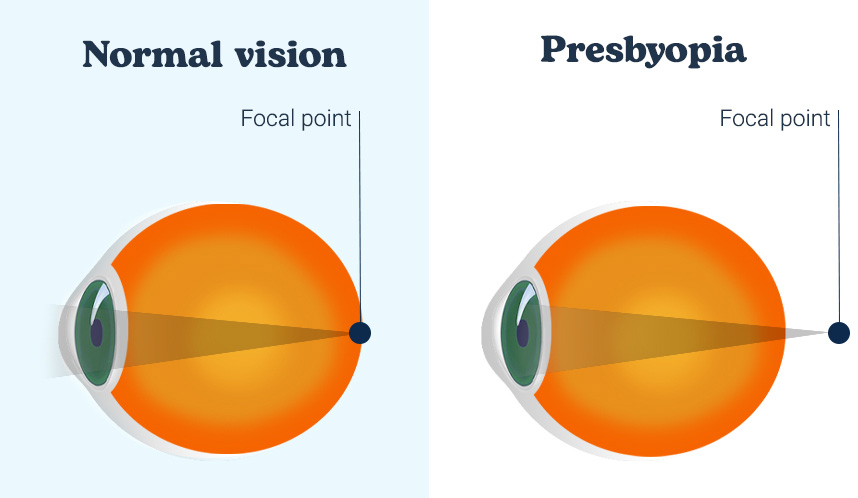Presbyopia is an age-related refractive error that results in the gradual loss of the eye’s ability to focus on nearby objects. It is a natural part of aging and typically becomes noticeable in individuals over the age of 40. While presbyopia is not classified as a disease, it can significantly affect quality of life if left uncorrected. Fortunately, numerous corrective solutions exist, ranging from eyeglasses and contact lenses to advanced surgical options.

What is Presbyopia?
Presbyopia derives from the Greek words “presbys” (old man) and “opia” (vision), meaning “elder vision.” It is characterized by the eye’s diminishing capacity to adjust focus for close-up tasks due to a loss of elasticity in the crystalline lens and weakening of the ciliary muscles that control lens shape.
Key Characteristics:
- Onset Age: Typically begins after 40
- Progression: Gradual, continuing into the late 60s
- Symptoms: Difficulty reading small print, eye strain, need to hold reading material at arm’s length
Anatomy Behind Presbyopia
The human eye focuses light on the retina via the cornea and lens. The lens changes shape through the action of the ciliary muscles to accommodate near or far objects—a process known as accommodation. With age, the lens stiffens and the muscles weaken, reducing accommodative ability.
Symptoms of Presbyopia
Presbyopia manifests gradually and can be easily confused with other vision problems. The most common symptoms include:
- Blurry vision at close range
- Eye fatigue or headaches during near tasks
- Difficulty reading small print, especially in dim lighting
- Frequent need to adjust reading distance
- Temporary improvement in near vision when squinting
These symptoms intensify with age and may impact daily activities like reading, sewing, or using a smartphone.
Risk Factors and Contributing Conditions
While presbyopia is age-related and affects everyone to some extent, certain risk factors may accelerate or exacerbate its onset:
- Hyperopia (farsightedness): May lead to earlier presbyopia symptoms
- Systemic diseases: Diabetes, multiple sclerosis, cardiovascular disease
- Medications: Antidepressants, antihistamines, diuretics
- Environmental factors: Excessive screen time, prolonged near work
Diagnosis of Presbyopia
An optometrist or ophthalmologist can diagnose presbyopia during a comprehensive eye examination, which includes:
- Visual acuity tests
- Refraction assessment
- Retinoscopy
- Ocular muscle function tests
- Slit-lamp examination
Routine exams are essential after age 40 to detect early changes in vision and update prescriptions as needed.
Presbyopia Treatment Options
1. Eyeglasses
The most common and non-invasive correction method. Glasses can be prescribed as:
- Reading Glasses: Single-vision lenses for close work
- Bifocals: Two distinct viewing zones—distance and near
- Trifocals: Includes an intermediate zone
- Progressive Lenses: Seamless transition across all distances
2. Contact Lenses
Contact lenses offer freedom from glasses with options such as:
- Monovision Lenses: One eye for near, the other for distance
- Multifocal Lenses: Combine near and distance zones in one lens
- Modified Monovision: Combination of monovision and multifocal designs
Success depends on patient adaptation and visual demands.
3. Surgical Treatments
Surgical interventions provide long-term solutions and are suitable for those seeking spectacle independence:
a. Corneal Inlays
Small implants placed in the cornea of the non-dominant eye to improve near vision.
b. PresbyLASIK
Laser eye surgery reshaping the cornea to create multifocal zones.
c. Refractive Lens Exchange (RLE)
Replacing the natural lens with a multifocal intraocular lens (IOL), especially effective for individuals with both cataracts and presbyopia.
d. Monovision LASIK
Laser correction giving one eye near vision and the other distance vision.
Each option requires comprehensive evaluation to determine suitability based on age, eye health, and lifestyle.
Managing Presbyopia Naturally
While presbyopia is a structural and age-related condition that cannot be reversed naturally, certain lifestyle habits can help manage or delay symptoms:
- Maintain eye hygiene
- Take regular visual breaks during near tasks (20-20-20 rule)
- Ensure proper lighting while reading or working
- Wear appropriate UV-protection sunglasses
- Consume an eye-healthy diet rich in antioxidants (vitamin A, lutein, omega-3s)
Regular eye check-ups remain critical for adjusting corrective measures and identifying co-existing eye conditions.
Innovations and Emerging Therapies
New frontiers in presbyopia management include pharmacological and implantable devices:
- Pilocarpine Eye Drops (Vuity™): FDA-approved drop that constricts pupils to improve near vision temporarily
- Adjustable IOLs: Allow postoperative fine-tuning of lens power
- Smart Lenses: Adaptive lenses under research that adjust focus electronically or thermally
Such advancements aim to reduce dependence on glasses and offer more personalized visual solutions.
Prognosis and Long-Term Outlook
Presbyopia is a progressive but manageable condition. With the right corrective strategy, most individuals maintain excellent visual function well into older age. Modern technology and regular eye care enable customized treatment plans that accommodate evolving visual needs.
Presbyopia is a universal and natural aging process that affects near vision clarity. While it cannot be prevented, the condition is highly treatable through a wide range of corrective options, from simple reading glasses to advanced surgical interventions. Early detection, regular monitoring, and personalized solutions are key to preserving quality of life and visual independence as we age.